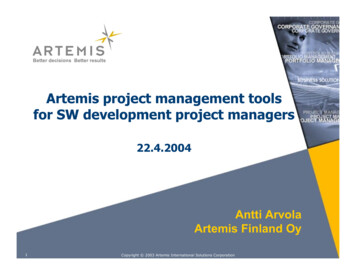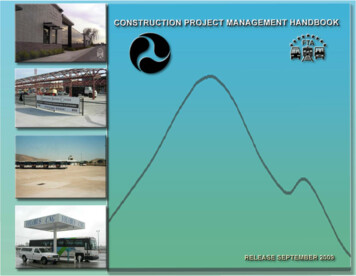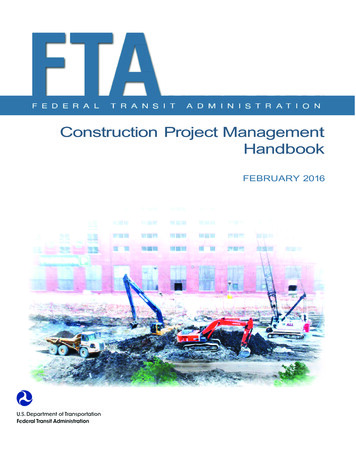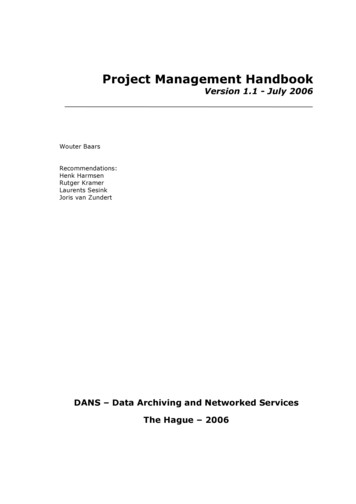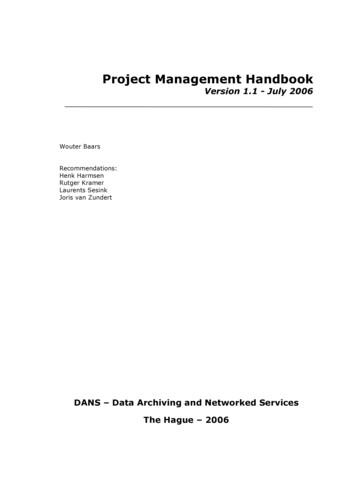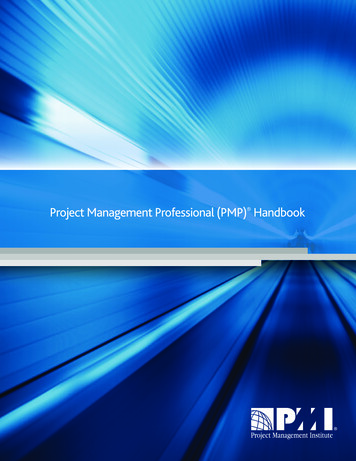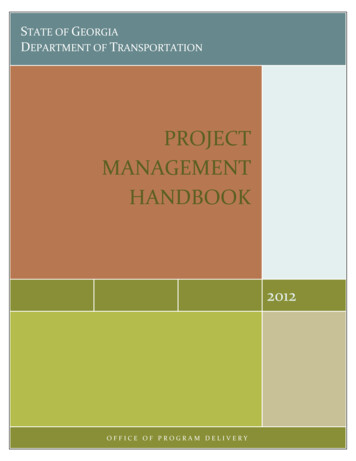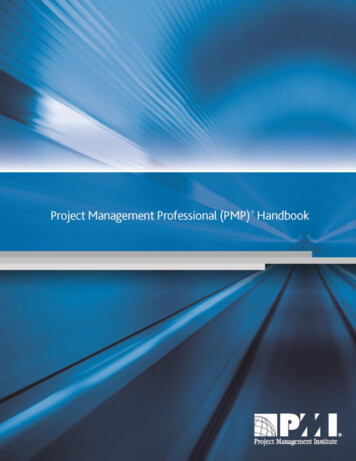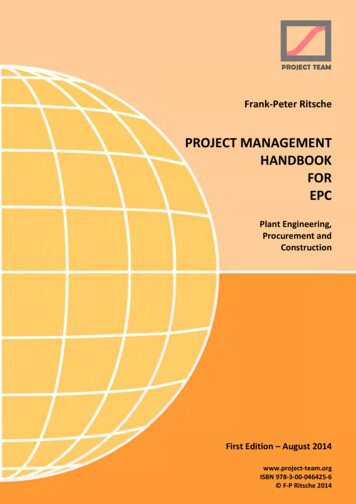
Transcription
Frank-Peter RitschePROJECT MANAGEMENTHANDBOOKFOREPCPlant Engineering,Procurement andConstructionFirst Edition – August 2014www.project-team.orgISBN 978-3-00-046425-6 F-P Ritsche 2014
PROJECT TEAMProject Management Handbookfor EPCCONTENT1Introduction11.1The Project Life Cycle21.1.11.1.3.11.1.3.21.1.3.31.1.3.4From Inquiry to WarrantyAcquisition PhaseBid PhaseProject PhaseWarranty PhaseThe PMI Life CycleProject InitiationProject PlanningProject ExecutionProject ControlProject ClosureThe EPC CycleProject ManagementEngineeringProcurementConstruction and Commissioning2346667888910101111121.2Application of Project Management Standards141.2.1Project Management StandardsISO 21500IPMA BS 6079PMI A translation into EPC's languageIntegrationScopeTimeCostQualityHuman ResourcesCommunication and .2.61.2.2.71.2.2.81.2.2.9 Ritsche 2014- i -
PROJECT TEAMProject Management Handbookfor EPC2Project Management202.1The Project Plan202.1.12.1.2.12.1.2.22.1.2.3Project Documentation HierarchyProject and Quality Plan - ISO 10006 and 10005Content of the project planExternal and Internal ProceduresProject Planning DocumentsManual of ProceduresProject ManualDesign ManualSite Manual2020212323242425252.2The Project Organization262.2.12.2.5Hierarchies of a Project OrganizationExternal organizationInternal organizationInterface to executive managementA special case: project joint venturesRoles and ResponsibilitiesProject DirectorSite ManagerProject Management FunctionsSupport FunctionsIntegration ManagementDefinition of interfaces – scope sharingInterfaces management inside and out of project boundariesReporting and decision makingDelegating responsibilities versus centralizing functionsInterface with the Home OrganizationHuman ResourcesStaffing and TrainingHuman Resources PoliciesProject 37382.3Project Structures392.3.1Work Breakdown StructuresWBS and Work-Package DefinitionWork Assignment ProcessPlant Breakdown StructuresMaterial Breakdown StructuresOther .3.4 Ritsche 2014- ii -
PROJECT TEAMProject Management Handbookfor EPC2.4Communication Management442.4.12.4.22.4.32.4.4Hierarchies of CommunicationCommunication PlanCorrespondenceMeetingsAction Items TrackingCrisis ManagementLessons Learned Process444545464647482.5Contract .5Contracting: The Bid PhaseBid and Contract PreparationBid and Contract ReviewAssumptions, Clarifications, ExclusionsLegal and Commercial AspectsContract Management Set-upContract Management OrganizationContract Management ProceduresContract Management Reviews and TrainingPreventive and Active Claim ManagementClaim Management StrategyScope and Cost Change ControlSchedule Change ControlActive ClaimsDefensive Claims5151525454565758606061626464662.6Time & Resources Management672.6.12.6.2Scheduling Organization and ProceduresSchedule DevelopmentTools, Database Structures, Access RightsSchedule HierarchySchedule Structures and Filtering CriteriaEPC SequencingInterfaces with other SystemsSchedule ControlBaseline Schedule and Schedule Change ControlSchedule Update and Corrective ActionProgress Reports, Graphics and KPI'sResource PlanningSkills and OrganizationQuantitative and Qualitative Personnel PlanningMan Load GraphicsResource Loaded ScheduleOther 4.22.6.4.32.6.4.42.6.4.5 Ritsche 2014- iii -
PROJECT TEAMProject Management Handbookfor EPC2.7Cost 2.7.4.5Commercial Organization and ProceduresCost PlanningBid Phase Cost EstimationOrder Income CalculationPayment Schedule and Cash-Flow PlanningCost ControlTracking of Actual Costs and HoursReporting Planned versus Actual CostsReporting POC, Earned ValueInvoicingBusiness AdministrationFinance: Loans, Interests, Hedging of foreign CurrenciesTaxes, Customs, FeesBonds and GuaranteesInsurancesLegal compliance848485858687878890939393949495962.8Risk Management972.8.12.8.22.8.3Risk Management Organization and ProceduresRisk Identification and QualificationRisk Mitigation and Action Tracking97981012.9QHSE Management1032.9.12.9.2Quality ManagementQuality PlanSupplier QualificationInspections, Assessments, AuditsNon Conformance ControlEnvironment, Health and Safety1031041051061081082.10Progress Reporting1132.10.1Internal ReportingDetailed ReportingProject Management ReportingExecutive ReportingExternal ReportingThe Reporting CycleA Monthly Reporting Time-ScaleProject Status .10.32.10.3.12.10.3.2 Ritsche 2014- iv -
PROJECT TEAMProject Management Handbookfor EPC2.11Document tation PlanningStandard List of Technical DocumentsInterface to Time ScheduleDocuments GenerationCodification, Classification, TemplatesInternal WorkflowsConfidentialityArchiving RequirementsAutomatic Generation from Engineering ToolsHandling of Supplier DocumentsDocuments Workflow ControlTransmittal and Client AcceptanceDocuments TrackingConfiguration Management for DocumentsLifecycle and Revision ControlRendition ManagementComposition of Virtual 11321321332.12Information Management1342.12.12.12.3Project specific IT-ArchitectureProject Management ToolsDesign Integration ToolsEngineering ToolsCommunication PlatformsProject DrivesWeb-Portals, Sec ure Extranet ServicesData Engineering Process & Procedures1403.1.1The Engineering DisciplinesSystems EngineeringMechanical EngineeringPlant Layout and Civil EngineeringElectrical, Instrumentation and Controls, HVACEngineering ITP&ID's and Engineering Database3D Plant LayoutImproving Engineering EfficiencyModularization and Engineering Re-UseCost .3.2 Ritsche 2014- v -
PROJECT TEAMProject Management Handbookfor EPC3.2Technical Configuration on Management PlanISO 10007 RequirementsDefinition of Configuration Management in EPC ProjectsTechnical Change ManagementDesign Reviews and Design FreezesTechnical Change NoticesData Status Tracking, Data RevisioningData Exchange/ Data Life CycleData Lifecycle Requirements for O&MData Handover to Owner/ OperatorStandardization of Data ing Management1613.3.13.3.2.13.3.2.2Requirements ManagementCodes, Standards, RegulationsRequirements Management ProcessLicensing PlanConstruction LicenseOperation urement Process & Procedures166Material Take-Off1684.2.14.2.2Material CatalogueGeneration of BoM1681694.3Procurement Planning1704.3.14.3.24.3.3SolicitationSupplier SelectionSupplier Contracts1701711734.4Procurement Control1744.4.14.4.24.4.3Purchase Order TrackingManufacturing and InspectionsTransportation and Export1741751764.5Stocks1784.5.14.5.24.5.3Material Reception on SiteSite Warehouse ManagementInterface to Financial Asset .23.2.2.33.2.33.3.1.13.3.1.23.3.2 Ritsche 2014- vi -
PROJECT TEAMProject Management Handbookfor EPC5Construction and Commissioning1805.1Site Management Organization and ite OrganizationSite Procedures & InstructionsAspects of International Construction SitesLegal status and registration obligationsTaxesHuman Resources1801811841841851865.2Construction 2.2.3Site Infrastructure and LogisticsSite layout and permanent facilitiesSite infrastructure and temporary facilitiesScaffolding and weather protectionHorizontal and vertical transportsConstruction processesCivil constructionMechanical erectionElectrical and I&C installations5.3Construction Execution and Control1975.3.15.3.2.15.3.2.25.3.2.3Site Coordination and Interface ManagementWord Order SystemSubcontractor ManagementField EngineeringInspection and SupervisionInspection Planning and Interface to EngineeringOrganization and Coordination of InspectionsNDE and Baseline 15.4.2Mechanical Completion ManagementCommissioning ProgramCommissioning documentationCommissioning processHandover to Owner/ 3 Ritsche 2014- vii -192193196
PROJECT TEAMProject Management Handbookfor EPC1 IntroductionForewordExcellence in project management is a key successfactor in doing business across all industries. Newinnovations in finance, in IT, in the health sector aremanaged as projects. The developments of newproducts in automotive, aerospace, shipbuilding, inany producing sector are managed as projects. Theplanning and construction works of new buildings,infrastructure or industrial plants are managed asprojects. Although the characteristics of such projectsdiffer significantly there are basic principles that applyto all different kind of projects.construction and commissioning of industrial plantsare called EPC contractors. I have been working in EPCprojects since more than 20 years, in ring facilities and on construction sites, inprojects from some hundred thousand Euros up toseveral billion Euros. I always was missing a guidelinethat translates the common project managementstandards into the complex and specific world of theEPC business. This is the reason why I wrote thishandbook.A couple of good project management standards havedeveloped around the globe, but I consider the ProjectManagement Book of Knowledge (PMBoK ) of the USbased Project Management Institute (PMI ) the mostaccurate and internationally recognized standard inthe world. The PMBoK knowledge areas can becorrelated with the ISO 21500 standard (Guidance onProject Management) that was edited in 2012 and isaimed to describe common sense among the variousproject management standards, organizations andindustries. These standards and associated guidelineshave evolved during the last years to a maturity thatthey can be applied to any project, no matter whatsize, no matter the nature of business. And exactlythat universality is the challenge we face in the EPCbusiness.The food served in this book is probably somethingheavy to digest for a project management beginner.The knowledge of project management standards suchas the PMBoK will definitely help to fully benefit fromthe lecture of this book and to apply it adequately toyour own organization. On the other hand – some ofthe tools and methods described here may only bereasonable for really complex mega-projects. Don’tcrack a smaller nut with a sledgehammer.The construction projects of large industrial plants areamong the most complex projects. Constructioncompanies who cover the engineering, procurement, Ritsche 2014- 1 -If you are a contractor in an EPC project, the owner oroperator of a process plant or a developer of projectmanagement software or engineering tools: I wish thishandbook will give you some practical ideas how toimprove your project. And I would like to invite you toshare your remarks with me to make this handbookeven better.Düsseldorf, August 2014Frank-Peter Ritsche
PROJECT TEAMProject Management Handbookfor EPC2.2 Project OrganizationFor complex EPC projects the project organization ismore than a project manager and his team. Standardslike the PMBoK address the project organization as ahuman resources issue. This is definitely correct andneeds to be addressed here, but it's more than that.With the project organization we assignresponsibilities to the individual shares of scope. Withthe project organization we define the interfacesbetween the different members of this organization,and these organizational interfaces can be the key tosuccess - or failure of the project. With the projectorganization we also need to set up the infrastructure,e.g. the arrangement of offices for the team. ThisSection will provide an overview of what needs to beconsidered for setting up the project organization, andhow this could be written down in a projectorganization procedure.Figure 2-62.2.1Hierarchies of a Project OrganizationThere are a thousand-and-one ways to organize aproject. There are aspects like the availability,capability, efficiency of resources, the minimization ofinterfaces or corporate business strategies thatdetermine the structure of an organization. There arestrong hierarchical organization forms, there arematrix organization forms. There is a permanent anization must fit into. What-ever the final projectorganization will look like: There is always an externaland an internal project organization hierarchy thatfollows some basic principles. And: the projectmanager must be aware that he has to ensure themanagement of all the interfaces within thisorganization.External organizationThe external project organization of an EPC projectdefines the high-level relationships between thedifferent companies involved in the project. From theperspective of the EPC or main contractor(s) in chargeto engineer, procure and build the plant, there aretypically two or more levels of subcontractors andtheir sub-suppliers that need to be managed. Anorganization chart of the external project organizationwill only show the most important ones, sincegenerally subcontractors and sub-suppliers will bemanaged through the procurement organization. If Ritsche 2014- 26 -the EPC or main contractor is not just one company,but a project joint venture (consortium) of two ormore companies, this needs to be reflected in theorganization chart of the external project organization.Above all that is the client as the top-level of theexternal organization, but there could be furtherorganizations that interface with the EPC (or client/owner/ operator) on a high level, e.g. licensingauthorities or an architect engineer. The followingfigure shall iIIustrate an example.
PROJECT TEAMProject Management Handbookfor EPCFigure 2-7The external organization is the basis for manycontractual relations in the project. Each link betweentwo boxes in this chart reflects a contract betweentwo parties. Each link reflects an interface that needsto be managed, and for which a set of proceduresshould be in place, how the two parties shall worktogether. Section 2.1.1.3 has already elaborated on2.2.1.2these procedures. For each of the parties in theorganization the share of scope must be dearlydefined: without overlap, and without gap. The"responsibility assignment matrix" is a tool to assignthe work-packages of the work-breakdown structure(WBS) to the organization - It will be described furtherbelow In Section 2.3.1.2.Internal organizationThe organizational set-up of the project team withinone of these boxes of the external organization is theinternal organization. Where the internal organizationFigure 2-8 Ritsche 2014- 27 -of a small project may simply consist of the projectmanager and his team, there will be a more complexorganizational hierarchy in a large EPC project.
PROJECT TEAMProject Management Handbookfor EPCSection 2.3 of this handbook will deal with the workbreakdown-structure (WBS) of a project, but one ruleshould be already mentioned here: the organizationstructure and the WBS are two different things.However there should be one principle respectedwhen defining the WBS and when defining the projectorganization: On the lowest level of both structures, itmust be possible to assign one single organizationalresponsibility to one or more work-packages of theWBS. This is why the lowest level of the projectorganization chart should be the manager of a workpackage. He has the full responsibility for planning,executing and controlling the scope of his workpackage, and he functions as a project manager for hissmall share of the project. He leads a small team, andhe follows the instructions given by the next highermanagement level of the project organization, wherehe also reports to.This intermediate level I have named the subprojectIevel. There could be more intermediate levels in aproject organization, but their function generally is thesame: The project manager of a subproject is the2.2.1.3interface manager of the work-packages that belongto his subproject. His main role is integrationmanagement, and he has to consolidate the reports ofhis work-package managers on the subproject-Ievel.At the same time he is reporting bottom-up to thenext-higher level.The highest level in a complex project organization isthe project director. He is the leader of the overallproject, and as he has broken down the overall projectinto a manageable number of subprojects, the projectmanagers of these subprojects report to him. Again,the project director is the interface manager of thesubprojects.In addition the project director will support the projectorganization with some centralized support functions.Typically the commercial project manager, timescheduling manager, quality manager or possibly acentral project documentation office are such supportfunctions. They will be described further below inSection 2.2.2.Interface to executive managementThe project director has the authority to take alldecisions within the boundaries of his project. He isempowered by executive management through aproject charter or a letter of delegation to execute theproject with the involvement of the correspondingorganization units of the home organization andexternal organizations.required that are outside the limits of the project, theproject director shall present to the steeringcommittee, which is responsible to drive the decisionto the appropriate level. The project director isresponsible to prepare such decisions with allsupporting facts, such that the steering committee isable to decide.For a large project with several external organizationsinvolved, it is common practice to establish a steeringcommittee, which represents the executivemanagement of the involved organizations. Theproject director will report to this executive steeringcommittee that acts as the ultimate decision level forissues or conflicts that cannot be solved within theproject directors' responsibility. If there are decisionsFor the project director it is important to fix theprinciples of cooperation between his project and thesteering committee in an organizational paper (e.g.the reporting lines, periodicity of board meetings,members of the committee), and to obtain a signedcommitment on these principles. This agreementshould be part of the project plan.2.2.1.4A special case: project joint venturesIn large construction projects two or more companiesmay join their forces in a project joint venture orconsortium. They will split the total scope among theconsortium partners and define their rules ofcooperation in a consortium contract. In front of thecustomer the consortium may act as one face (closedconsortium), or may maintain direct relations between Ritsche 2014- 28 -the individual partners and the client (openconsortium). The consorti
2.2.2.3 Project Management Functions 31 2.2.2.4 Support Functions 32 2.2.3 Integration Management 33 2.2.3.1 Definition of interfaces – scope sharing 33 2.2.3.2 Interfaces management inside and out of project boundaries 34 2.2.3.3 Reporting and decision making 34 2.2.3.4 Delegating responsibilities versus centralizing functions 35



